Christopher Wilcox believes there are two kinds of people in the world: those who, if given the choice, would jump forward in time, and those who would go back. “I’m someone who would go back,” he says, in a precise Cornish accent. Wilcox, 38, has made a career out of his obsession with the past. He is the founder of Natural Curiosities, a wildly successful Los Angeles studio that produces artwork for interior designers, hotels and boutiques. The signature look might be described as post-modern antiquarian. Wilcox owns more than 75,000 natural history prints, paintings and artifacts from the 16th century up to the present; using the tools of digital design, he scans and manipulates them into prints. Out of their original contexts, the images take on surprising new life. Among Wilcox’s favorites is an engraving of Noah’s Ark from an old Dutch Bible: He enlarged it to a giant 84-by-30-inch print and hand-colored the animals. To Wilcox, the Ark is a moving example of nature’s mystique. “The notion of the animals being saved is so romantic,” he says.
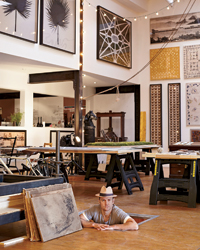 Christopher Wilcox at his Natural Curiosities Studio.
Christopher Wilcox at his Natural Curiosities Studio.Wilcox’s idol is 17th-century apothecary Basilius Besler, whom he regards as the original urban farmer, and whose Hortus Eystettensis, an atlas of plant engravings, is often credited with inventing the genre of botanical artwork. Like Besler, Wilcox’s latest project is inspired by his own urban farm: This spring, he and his partner, Sera Pelle, will launch an online retail venture called Tertius (tertiushome.com) to bring their neo-agrarian aesthetic directly to the public. Along with art, Tertius will offer kitchenware, furniture, toys, dry goods and vintage accessories, all designed or sourced by Pelle and Wilcox: a wooden bench shaped like a broad bean, rustic wire baskets, a metal herb planter on wheels. Wilcox will also sell art he creates by pulling taproots from crops, scanning them at ultra-high resolution and enlarging the images. “There’s a world of work to be done with roots,” he says.
Roots figure into Wilcox and Pelle’s lives, both literally and metaphorically. The couple, who met three years ago, live in a midcentury house high in the Hollywood hills, on a narrow, dead-end lane that’s practically unfindable without GPS. Their one-acre plot, now in its second season, stretches into a neighboring lot that Pelle and Wilcox rent from its owners for the price of an occasional basket of produce.
“We have our own little ecosystem here,” says Pelle, who is also consulting chef at a vegan-friendly gastropub called Mohawk Bend. She’s standing over two sizzling skillets in the couple’s kitchen, frying eggs from the farm’s heritage chickens. “The children wake up and run outside to collect eggs,” she says. Between them, the couple has four girls and one boy who earn a dollar an hour for their work as apprentice farmhands. On the tile counter sits an array of just-picked produce: eggplant, pumpkin, pomegranate, lemon and a giant rosette of butter crunch lettuce, all of it illuminated by a ray of filtered sunlight. The tableau suggests Caravaggio by way of Alice Waters. Pelle serves up three of the most beautiful egg sandwiches I’ve ever seen, marigold-hued yolks layered with avocado and sautéed mustard greens.
We’ve hardly begun eating when we hear a noise. “Parakeets!” Wilcox shouts, as a flock of them squawk between the eucalyptus trees. He and Pelle lunge for the balcony. “Not many things will get us off the table, but birds will,” he says.
For lunch, we drive to the Natural Curiosities studio, which is housed in a defunct, 1920s-era, King-Tut-themed bowling alley in nearby Echo Park. (Wilcox’s grandfather was an Egyptologist for the British Museum, so he has a particular affinity for the building.) Inside, the space feels magical and eclectic, like a life-size Joseph Cornell box. One wall is hung with old fedoras and bowler hats, another with vintage duck decoys. Coral fronds are piled inside the type of massive rolling laundry bins used by movie convicts for prison escapes. An entire room is dedicated to butterfly specimens.
Wilcox founded Natural Curiosities in 2005, shortly after emigrating from England, where he worked as an antiquarian book dealer. “California is the most creative environment I’ve ever been in,” he says. “When I landed here, I literally kissed the earth.” He started the company with nothing but the portfolio of vintage botanical prints he’d picked up at auctions around the UK. As Natural Curiosities has expanded—the company now produces around 350 pieces a week—so has Wilcox’s collection. One week he might be wandering the Black Forest in search of antique keys, the next scouring local bookstores for campy Harlequin romance novels. These found objects are integral to the artwork Natural Curiosities started creating two years ago. On any given day, staff artisans might be affixing thousands of dried rosebuds to a blueprint of a 17th-century French garden, or scanning 200-year-old bottles dredged from an Alaskan river for X-ray–like prints that would look at home in a steampunk-themed cocktail bar.
At lunchtime, some 15 of us convene around a wooden table with built-in stools—a relic from an old bakery. The atmosphere is as buzzy and chummy as an art school dorm. Today, Pelle has prepared a salad of red cabbage, mandarin oranges, fennel, cilantro and pepitas, garnished with calendula petals. “A dish should show the colors of the rainbow,” she says. “Instead of this food group and that food group, just be sure there’s a lot of color.” It’s enough to induce a kind of gustatory synesthesia: Does the food taste better because it’s beautiful, or is the beauty a trick of its flavor?
Blurring the lines between food and art is the Tertius mission. Wilcox’s scanned root images might be the best example. Like a canner putting up vegetables, he is preserving something of the present for future enjoyment. It’s a telling departure for someone whose aesthetic preoccupations have, generally, been focused on the past. When I suggest as much, Wilcox thinks for a moment and finally nods. He agrees that perhaps now—with Pelle and their blended brood, heritage hens and heirloom seeds, one successful business and another in the works—he’s looking forward when he used to look back.
Lila Byock has written for The New Yorker and Mother Jones. She lives in Los Angeles.
Four highlights from Natural Curiosities’ new Tertius collection, available at tertiushome.com.
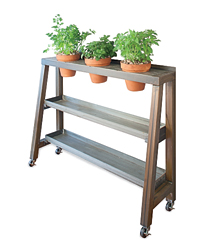
Made of welded metal and set on wheels, this planter is designed to follow the sun ($795).
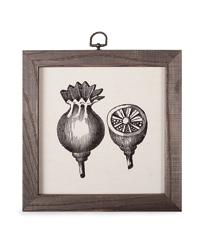
From an engraving of seeds and plants, reproduced and placed in an ash wood frame ($195).
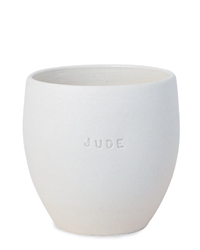
Japanese-inspired tea cups can be imprinted with a monogram or name using old typewriter keys ($85).
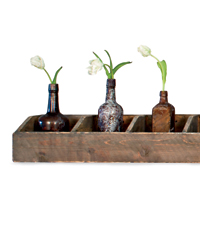
A rustic shelf to hold antique bottles or bud vases ($495–$595).
No comments:
Post a Comment